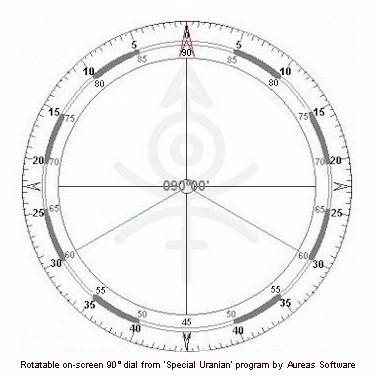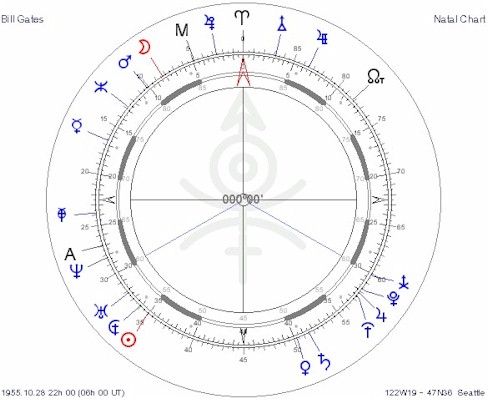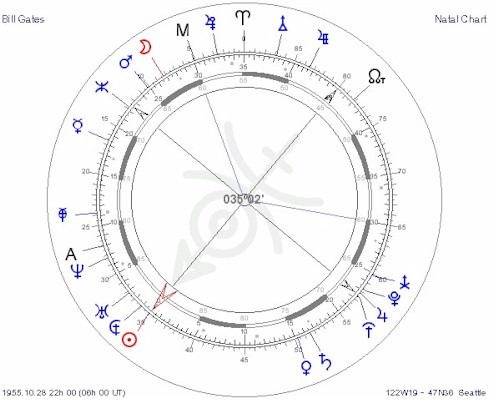Planetary Pictures We have the chart data to enter into our computer program and now need to ascertain the correct time zone and whether hours are to be added or subtracted. 行星图象 在我们在计算机程序中输入自己出生资料的时候,必须确定准确的时区,时间到底是需要加还是减。 To prepare for our work, we will need 3 types of printout: 1) A data list showing the longitudes of the planets, transneptunians, and relational points, 2) a horoscopic chart in the 90° format with space for placing a 15-centimeter dial in the middle, and 3) a listing of the midpoints in the chart notated in the 22.5° system (16 th harmonic). 在开始工作前,我们需要以下三步 1、行星还有相关点的位置清单。 2、一个 90dial 盘,一个 15cm 的指针:) 3、一个星盘中点的清单, 位置用 22.5 度( 16 倍相位)表示。 These printouts are available in the Aureas Special Uranian program, desgined specifically for use with our lessons. And to perform our work, we will need one of 2 things: either a) the Aureas Special Uranian program, which includes a versatile on-screen 90° dial chart, with functions that make midpoint analysis easier than when using a printed chart and dial manually, or b) a printed 90° chart, which the Special Uranian program also provides, and should be used with a 15-centimeter 90° dial with either a pin or nut-and-bolt to secure it to a clipboard. Please contact finblake@mindspring.com if you need a 90° dial suitable for our work. 要继续工作我们还有以下两步要做 A) 一个能作 90dial 盘的程序,最好能简单的分析中点 b) 推销这个软件的,我下了但是demo不能用呵呵不知道是不是自己系统有问题。 An illustration of the 90° dial can be seen here. 一个90dial盘的实例
The dial shows two rows of numbers. Starting at 0°, we see the degrees marked in 5° increments, on both sides, around the outer circle of the dial, until we reach 45°. Then we take note of the second circle inside, which starts with 45° and continues up to 90°. Thus we see 5° on the outer circle corresponding with 85° on the inner, 20° to 70°, 30° to 60°, and then 45° to 45°. Because of this arrangement, we can easily detect symmetrical relationships within the chart. Dial 盘显示了两圈刻度。外圈由 0 度开始,每五度一个标记,向两边增加,到 45 度结束。第二圈开始与 45 度,到 90 度结束。外圈的 5 度对应内圈的 85 度, 20 度对应 70 度, 30 度对应 60 度, 45 度对应 45 度。这样的排列让我们能够很容易的察觉行星之间的对称关系。 The pointer (at 0° and 90° of the dial) can be set toward any given point on the chart. We will then note where each of the other factors in the chart is located in relation to 0°. 停在外圈 0 度和内圈 90 度的指示器,可以对准星盘中的任何一点,我们就可以发现任何其他一点与 0 点之间的关系。 At this point, I would like to relate a story. One day, Alfred Witte was sitting at the shore and threw a stone into the water. He observed how small circular waves emanated outward from where the stone first contacted the water. Then, when he threw two stones into the water at the same time, he noted that at the central meeting point of the two circular patterns, a straight line was formed. 在这一点上,我想讲一个故事,一天怀特在海边扔了一块石头到海里,他发现掉入海中的石头只能激起一些小的圆圈形波纹。然后他同时扔了两块石头到海里,他发现由两块石头引起的圆形波纹相交时会形成一条直线形波纹。 We can also observe similar patterns in the movements of a boat. If it is stopped in a still harbor with the motor turned off, it creates practically no waves. However, if someone starts the motor and the propellor begins to turn, continual circular motion is triggered in the surrounding water. Traveling outward, away from the shore, the boat arrives in proximity to other boats, and at the point where the waves created by each boat meet, we also see a straight line formed in the water. 我们在行船的时候一样可以观察到这个现象,如果船关掉发动机停在港口,它几乎不会产生波纹 , 但是一旦有人发动马达,水面上就会出现连续的波纹,如果开船离开港口接近别的船,在两艘船各自形成的波纹中间会出现一条直线。 We can translate this undular motion into what would occur out in the cosmos. Every planet, due to its rotation, sends vibrational waves out into the atmosphere, and straight lines result when they meet up with the vibrations of other planets. This motivated Alfred Witte to take note of the significance of midpoints. When the energies of any two planets intermix, they counteract yet ultimately complement each other in a remarkable manner. In cases where a third planet lies at the midpoint of the first two we just considered, a "planetary picture" is formed. On page 54 of the German anthology "Man: A Receiving Station of Cosmic Influences", Alfred Witte wrote: "A planetary picture is formed by three planets when one of them is located at the midpoint of the other two. These three planets can actually exist in six possible sequences in relationship to each other; and within these six possible sequences, each of the three planets will lie at the midpoint of the other two in 2 of the 6 sequences"; and he continues: "the two outlying planets would together exert an influence on the planet occupying their symmetrical axis." 在一些例子里面,当第三颗行星正好落在两颗行星的中点上时,我们认为行星的图像已经形成了,在德国人的占星学书籍里面写到“人:宇宙影响力的接收站”怀特写到“当一颗行星落在另外两颗行星的中点上时,三颗行星形成了一个行星图像。这三颗行星有六种可能的次序互相影响,在六种可能的次序里,这三颗行星都可能落在另外两颗的中点上,距离较远的两颗行星会一起向正好出现在他们对称轴上的行星产生影响” Now, in a personal chart we will observe how planetary pictures are detected. Thus we will look at the natus of Bill Gates, born 1955.Oct.28 at 22h00 PST in Seattle (122W20 x 47N36). 现在,让我看看行星图像是怎么在个人星盘中被发现的。我们可以看比尔盖茨的本命盘 1955.Oct.28 at 22h00 PST in Seattle (122W20 x 47N36)
First, we set the 0° pointer of the dial on 0° Aries of the chart and look to the right and to the left for symmetrical relationships. We refer to this approach as investigation of the axis. We will find factors to either side at approximately the same degrees, left and right. Since with the 90° dial we have a fourfold magnification of the 360° dial, it is easier to recognize more precisely where the midpoints, as well as the individual factors, are located. The 90° dial is also easier on our eyes. In our later years in particular, we would all want to preserve our vision and protect the sensitivity of our eyes. At the distance of 3°, we find Cupido to the left and Vulkanus to the right, notated as CU/VU. At 5° we find the MC to the left and Apollon to the right, actually closer to 6°, notated as MC/AP. 首先,我们我们把 0 度的指针放到白羊座的 0 度上,然后看看指针的左边和右边有哪些星体对称。这个方法就像研究轴线一样,我们可以发现两端有着近似度数的星体,由于 90dial 盘把 360 度盘放大 4 倍,比起那些单独的它更容易发现中点的位置, 90dial 盘对你的眼睛也是有好处的,你也希望保护的眼睛吧:)在 3 度左右,我们发现丘比特在左边 3 度处弗卡努斯在右边 3 度处,简写为 CU/VU 。 5 度处,的我们发现 MC 在左边,阿波罗在右边,非常接近 6 度,记为 MC/AP 。 If we now go back to the concept of the planetary picture, incorporating the factor in the middle, we note that AR=CU/VU=MC/AP, and we thus have 2 single planetary pictures. In order to find further pictures, we could also quickly glance at a printout listing the midpoints. 如果现在回到行星图像这个概念上,我们可以把这种关系记为 AR=CU/VU=MC/AP 由中点引发的关系让我们有了两个行星图像,我们可以快速的浏览中点清单来找到更多的行星图像。 The Sun, as the source of life and vitality, is the most important point in a chart. We now rotate the dial so that 0° points to the Sun and we look for symmetries.
We find at 22° and 23° Jupiter and Kronos on one side, and Poseidon on the other. This can be notated as JU/PO, KR/PO. This alone is the indicator of a unique personality in a special position. In working with the 16 th harmonic, JU.KR.PO show up as being equal in value to the Sun, and this combination is therefore a unifying theme in all midpoints lying on this axis. 太阳,生命的活力来源,是星盘种最重要的点,我们现在旋转指针让它对准太阳,这样 0 度就指向太阳,我们就可以寻找对称在太阳左右的行星。 我们可以发现在 22 度和 23 度木星与克隆纳斯在一边,波赛东在另外一边。这个可以记为 JU/PO KR/PO ,这是都能反映独一无二的个人性格。在 16th 倍相位图里面 JU KR PO 与太阳重合,这个合相,奠定了所有落在这个轴上中点所反映的主题。 Next, at 25° we find Mars and Zeus, or MA/ZE. Thus, as a unified or combined planetary picture, we have SU=JU/PO=KR/PO=MA/ZE=MO/ME, or in 22.5° notation, SU=JU=KR=PO=MA/ZE=MO/ME. 然后,我们又可以发现在 25 度的地方,火星和宙斯, MA/ZE ,这样作为一个统一的行星图像我们可以这样写 SU=JU/PO=KR/PO=MA/ZE=MO/ME 或者在 22.5 度盘中的符号, SU=JU=KR=PO=MA/ZE=MO/ME 我们以后在对这个做解释,现在我们只是阐述这个技术。 We will consider the interpretations later. At this point, we want to first clarify the technique. Similarly, when adjusting the dial to any given factor, we can find a series of midpoints which altogether form a combined, or complex, planetary picture. 同样的,当把指示器对准一个制定的目标,我们能找到一串的中点,所有的中点就能组成一个复合星图。 |
|


